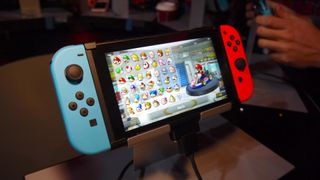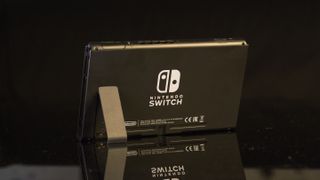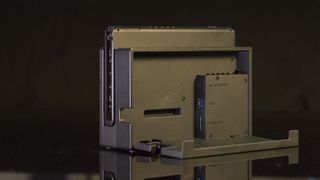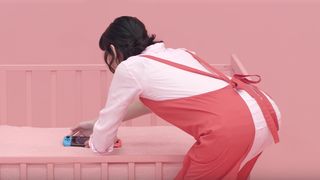Nintendo Switch review

You can always rely on Nintendo to try something unique. The Wii popularised motion control, the Nintendo 3DS brought in glasses-free 3D screen tech and the Wii U, for all its faults, had some interesting second-screen gaming ideas.
The Nintendo Switch continues in that fine tradition. Is it a handheld console? A home console? A transforming console? It's all these things and more, as Nintendo blurs the lines between gaming on-the-go and at home.
It's a fantastic proposition, and one that, going by the console's early successes, looks set to rival even the original Wii in terms of popularity.
It’s a neat idea, and it’s one that intuitively makes more sense than the Wii and Wii U’s premises. After all, both consoles relied upon developers finding interesting uses for the new form factors. Wii Sports did this magnificently for the Wii, while developers had to work a little harder to make use of the Wii U’s Gamepad.
The Switch’s central premise, meanwhile, is something that can benefit literally every game. After all, who hasn’t wanted to take their console with them in the past to enjoy full home gaming experiences on the go?
For the most part, the console delivers well on this premise. It’s a solid, premium-feeling handheld, and works more or less as you’d expect a home console to work when you need it to.
It’s not perfect, and there are a couple of issues that prevent it from being a complete success, mostly related to the fact that it’s a console that’s trying to do multiple things at once; but for the most part the console finds a good compromise between its dual personalities.
Nintendo Switch price and release date
- What is it? Nintendo's newest console
- When did it come out? March 3, 2017
- What does it cost? $299.99 in the US, £279.99 in the UK, $469.95 in Australia
Design
- Three form factors; handheld, console (docked) and tabletop
- Lots of accessories, which are at risk of being misplaced
In the Nintendo Switch box you get the main body of the console, complete with two detachable controller sides, a grip which enables you to combine these controller portions into a more traditional gamepad, two straps which can be attached to these sides to make them into two individual controllers, and a dock that allows you to plug the console into your television.
You also get a USB Type-C power cable (with a non-detachable power brick) and an HDMI cable for connecting the device to your TV.
If you think that sounds like a lot of accessories then you’d be right, and we suspect a lot of people are going to end up misplacing at least one or two of them after some months with the console.
We’ve taken to wrapping our Joy-Con straps around our Joy-Con grip just to keep everything together, but it would be great if there was some way of attaching them to the console so they don’t end up getting misplaced.
It’s a pretty novel (not to mention somewhat complicated) setup, so it’s worth delving into each of the different ways you can use the console.

Handheld mode
- Bigger than traditional handhelds
- Slightly cramped for the right hand due to right analogue stick
- Split D-pad on the left side
First up is handheld mode, which is the form factor that’s most like the hardware that’s come before it.
In this configuration you attach the two controller portions (the Joy-Cons) to the left and right edges of the screen, and you use the console much like the PlayStation Vita.
In fact, the size and shape of the console’s analogue sticks make it feel a lot like a modern Vita, although it doesn’t feel as solid because of the joints that exist between the Joy-Cons and the screen.
Along the top of the device you’ve got a slot for game cartridges, a headphone jack (bluetooth headphones/headsets are not supported), a volume rocker and a power button.
The bottom of the device is a much more spartan affair. You’ve got the kickstand for using it in tabletop mode (more on this later) concealing a small microSD slot which provides the console’s expandable storage. Internal storage is limited to just 32GB, so if you’re planning on downloading games rather than buying them then you’re going to want to invest in a microSD card (capacities up to 2TB are theoretically supported).
Check out TechRadar's unboxing video of the new console below.
The detachable Joy-Cons have a lot going on. The right hand side has the classic A, B, X, Y button configuration that Nintendo has used on and off since the SNES, an analogue stick (slightly awkwardly placed underneath the face buttons) and two shoulder buttons. There’s a small plus-shaped button which acts as the equivalent of the Wii U’s ‘Start’ button, and a home button for reaching the console’s system-level menus.
Across on the left Joy-Con it’s a very similar story. You’ve got a minus button that acts as the console’s ‘Select’ button, a share button for taking screenshots and video (in selected titles), an analogue stick, two shoulder-buttons, and the most un-Nintendo D-pad we’ve ever seen.
Instead of the classic cross D-pad Nintendo has utilised since the NES, the left Joy-Con instead has a set of four circular buttons that are identical in shape to the face buttons on the right Joy-Con.
This decision, which appears odd at first glance, has actually been made so the left Joy-Con can be used as an individual controller, with the D-pad acting as face-buttons in this configuration

Console mode
- Connects to your TV via an included dock
- Docking process is seamless, and can be done mid-game
The second form-factor is console mode. You place the main portion of the console in the included dock, this connects the device to your television, and you’re then free to detach the Joy-Cons to control the Switch from a distance.
The way the console transfers the viewing experience from its own screen to the television is as seamless as it could possibly be. You don’t even have to pause your current game – it happens completely in real time.
Detaching the Joy-Cons can be a little fiddly, but is essentially done by holding a small button on their backs and sliding the controller up.
This TV dock is around the same size as the Switch’s middle portion. Around the back you’ve got a USB Type-C port to provide the console with power, an HDMI port to connect it to your television, and a USB Type-A port.
On the left-hand side of the console are a further two USB ports, which will mainly be used for charging your controllers as you play wirelessly (more on this later too).
If you want to use the Switch with multiple televisions throughout your home then you can buy additional docks, which should make it easy to transition from one screen to another.

Tabletop mode
- Screen can also be detached and propped up on a table
- Great for 2-player gaming, but 4-players on the console's small screen is a push
The final form factor is what Nintendo calls ‘tabletop mode’. Using the kickstand that’s attached to the back of the screen you can prop the console up on a table and then detach the Joy-Cons for some semi-portable gaming.
In theory this is a perfect fit for long journeys on public transport where you have a tray table to place the console on, but this is a bit of a mixed experience.
It's certainly lovely being able to use the Joy-Cons in the grip rather than having them attached to the console. The grip provides just enough extra plastic to make the controllers much more comfortable in the hands, and having the console a little further away from you means that your sitting posture feels a lot more natural.
Tabletop mode is also great for multiplayer gaming. Detaching both Joy-Cons to allow two people to play against one another is a pleasure. This makes the console perfect for whipping out at small gatherings where you'll already have everything you need for a multiplayer session.
But there are a couple of issues that prevent the console from fully capitalising on tabletop mode.
First is the kickstand. Although it's rubberised, which means that the console doesn't slide around, it only supports the console at a single height. This means that if your tray table is a little closer to you then there's no ability to prop the console up so that it's facing you more directly. You'll instead be stuck with the screen pointing at your chest rather than face.
Second is the charging port, which is inaccessible when your using it in tabletop mode. During a recent train journey this meant that although we were in the perfect situation to use tabletop mode, we ended up using the console as a handheld so that we could make use of the charger next to our seat.
Finally, when it comes to multiplayer gaming, the screen is just a little too small for more than two players. Four player Mario Kart is almost impossible due to the size and resolution of the screen, and we found ourselves trying to put our face mere inches from the console to be able to make out more distant details in the game's tracks.
Overall it feels as though tabletop mode is better suited to short periods of use, which is a shame when it should be the defacto way to use the console over long periods.
Set-up
- Set-up is simple
- Console will need to be told whether Joy-Cons are being used together or separately
Setting up the new console is suitably simple.
If you’re using the device as a handheld then simply attach the Joy-Cons and press the power button.
If you want to play games on your TV you’ll need to plug the dock into the TV via HDMI, and hook it up to some power via the included USB Type-C power lead. The console then easily slips into the dock.
Pairing the controllers is a little more complicated than with other devices because of the fact that they can either be paired or used separately. The way you tell the console which controllers you’re using is to press both the L and R shoulder buttons in whichever configuration you’re using.

This means that if you’re using the Joy-Cons individually you can press the buttons on the Joy-Con straps to indicate that this is the case.
On the software side the console will ask you for the standard combination of Wi-Fi details and user account set-up info. These details are a doddle to input if you make use of the console’s touchscreen; the keyboard isn’t quite as good as a smartphone’s, but it’s a lot better than using a traditional controller.
After that’s done you’re able to play games off a cartridge, or games that are saved on the system’s memory.
With the Nintendo Switch having to work as a handheld as well as a home console, we were initially worried that the console’s graphical abilities would be limited.
Internally the Switch is using an Nvidia Tegra X1 chip, which is broadly similar to what was found in the Nvidia Shield. That’s not exactly a bad thing considering the Shield is a 4K-capable set-top box, but you have to remember that as a portable device the Switch needs to make compromises to ensure a good battery life.
At launch, concerns over graphical horsepower appear to be partly borne out, but we wouldn’t call them deal-breakers – we’d say the Switch’s graphics appear to be roughly equivalent to the Wii U.


Graphical performance
- Roughly equivalent to Wii U
- Not as good as PS4 or Xbox One
- Strength of Nintendo's art direction makes up for technical shortcomings
The Legend of Zelda: Breath of the Wild, for example, runs at a resolution of 720p on the Wii U, while this is boosted to 900p on the Switch when docked and outputting to a Full HD screen (4K output is not supported).
On the surface this suggests the Switch has the graphical edge on the Wii U, but we experienced frequent frame rate drops when playing the game on our television.
Meanwhile, when played on the Switch’s own 720p screen, the game maintained a consistent frame rate.
These initial observations suggest that we’re looking at a new console with roughly equivalent power to Nintendo’s last-generation system, but we'll see how the situation improves as developers get to grips with the new hardware.
 Nintendo has never been one to push the graphical envelope. Past games such as the Wii U’s Mario Kart 8 have certainly looked good, but this has been more as a result of their distinctive art style than the technical prowess of their graphics.
Thankfully this has tended to be a strong suit of Nintendo’s in the past.
The look of the games (in handheld mode at least) is also helped by the quality of the Switch’s screen. Although it’s only 720p resolution, the screen is bright and its colours are vibrant. It’s not up there with the best smartphones on the market, but it’s a step above Nintendo’s past handhelds.
We'll have to see what the Nintendo Switch achieves in the graphical department going forward, but we don’t expect this to be a console to rival the graphics of the PS4 and Xbox One.
The games we’ve seen look very good for handheld games, but as console games they don’t quite have the same fidelity of current-generation games on other consoles.
Nintendo has never been one to push the graphical envelope. Past games such as the Wii U’s Mario Kart 8 have certainly looked good, but this has been more as a result of their distinctive art style than the technical prowess of their graphics.
Thankfully this has tended to be a strong suit of Nintendo’s in the past.
The look of the games (in handheld mode at least) is also helped by the quality of the Switch’s screen. Although it’s only 720p resolution, the screen is bright and its colours are vibrant. It’s not up there with the best smartphones on the market, but it’s a step above Nintendo’s past handhelds.
We'll have to see what the Nintendo Switch achieves in the graphical department going forward, but we don’t expect this to be a console to rival the graphics of the PS4 and Xbox One.
The games we’ve seen look very good for handheld games, but as console games they don’t quite have the same fidelity of current-generation games on other consoles.




Comments
Post a Comment